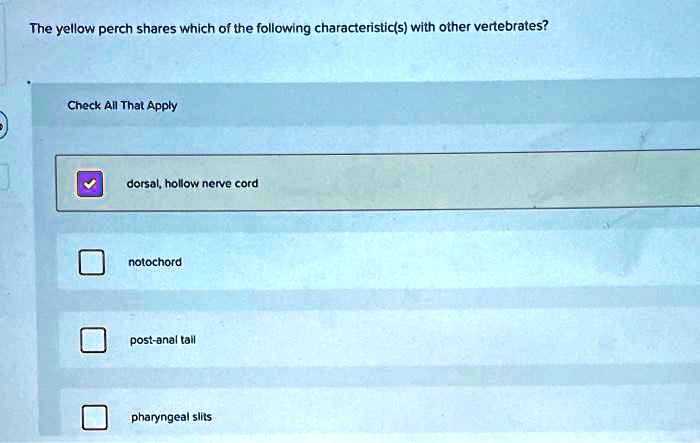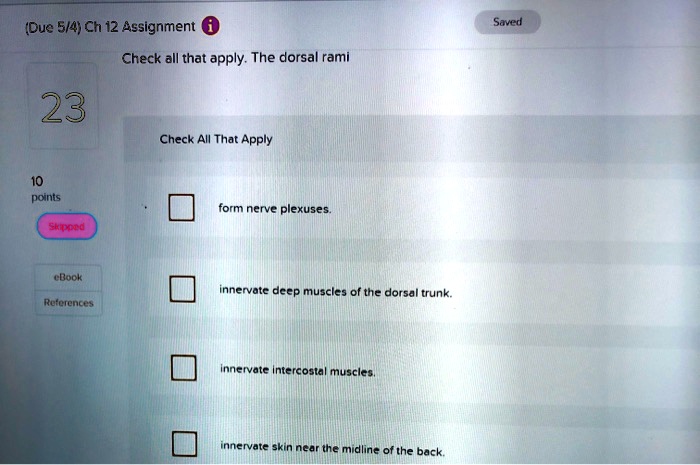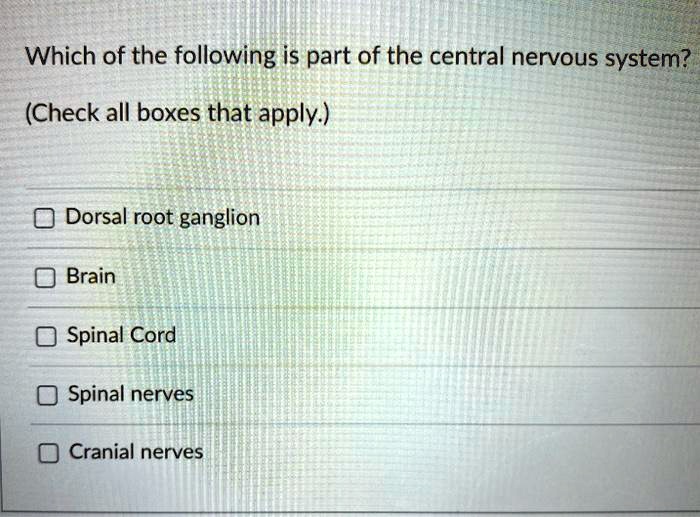Check all that apply. the dorsal rami – The dorsal rami, a crucial component of the nervous system, play a significant role in sensory and motor functions. Understanding their anatomy and clinical significance is essential for healthcare professionals.
Composed of spinal nerves, the dorsal rami emerge from the spinal cord and innervate various structures, including muscles, skin, and joints. Their branches contribute to sensory perception, motor control, and autonomic functions.
The Dorsal Rami

The dorsal rami are branches of the spinal nerves that emerge from the spinal cord and travel posteriorly through the intervertebral foramina. They innervate the muscles and skin of the back, as well as the joints and ligaments of the spine.
The dorsal rami are typically smaller than the ventral rami, which innervate the muscles and skin of the limbs and trunk.The dorsal rami are formed by the union of the dorsal rootlets, which are the sensory fibers of the spinal nerves.
The dorsal rootlets enter the spinal cord and synapse with neurons in the dorsal horn. The axons of these neurons then exit the spinal cord as part of the dorsal rami.The dorsal rami travel posteriorly through the intervertebral foramina, which are the spaces between the vertebrae.
They then divide into medial and lateral branches. The medial branches innervate the muscles and skin of the back, while the lateral branches innervate the joints and ligaments of the spine.Some of the nerves that form the dorsal rami include the:
- Occipital nerve
- Cervical nerves
- Thoracic nerves
- Lumbar nerves
- Sacral nerves
The dorsal rami are an important part of the nervous system, as they provide sensory innervation to the back and motor innervation to the muscles of the back.
Branches of the Dorsal Rami

The dorsal rami are the branches of the spinal nerves that exit the vertebral column through the intervertebral foramina. They divide into several branches that innervate the skin, muscles, and joints of the back.
The main branches of the dorsal rami are:
- Medial branches:The medial branches innervate the muscles and joints of the vertebral column.
- Lateral branches:The lateral branches innervate the skin and muscles of the back.
- Posterior branches:The posterior branches innervate the skin and muscles of the scalp.
The dorsal rami contribute to both sensory and motor functions. The medial branches provide sensory innervation to the vertebral column, while the lateral and posterior branches provide sensory innervation to the skin and muscles of the back. The medial branches also provide motor innervation to the muscles of the vertebral column.
Clinical Significance of the Dorsal Rami

The dorsal rami play a crucial role in various musculoskeletal conditions, influencing sensory and motor functions. Damage to these nerves can result in sensory deficits, pain, and impaired motor control.
Role in Musculoskeletal Conditions, Check all that apply. the dorsal rami
The dorsal rami innervate muscles, skin, and joints, transmitting sensory information to the spinal cord and carrying motor commands from the spinal cord to the muscles. Dysfunctions in the dorsal rami can lead to:
- Muscle weakness or paralysis
- Sensory disturbances (numbness, tingling, burning pain)
- Joint pain and stiffness
- Referred pain (pain felt in areas other than the site of nerve damage)
Diagnostic Tests and Treatment Options
Diagnosing dorsal rami-related disorders involves a combination of physical examination, neurological tests, and imaging studies (e.g., MRI, CT scan). Treatment options depend on the underlying cause and may include:
- Medications (e.g., pain relievers, anti-inflammatories)
- Physical therapy
- Injections (e.g., epidural steroid injections)
- Surgery (in severe cases)
Understanding the clinical significance of the dorsal rami is essential for accurate diagnosis and effective management of musculoskeletal conditions affecting these nerves.
Comparative Anatomy of the Dorsal Rami

The dorsal rami, branches of the spinal nerves, exhibit remarkable diversity across different animal species, reflecting adaptations to their respective ecological niches and locomotor patterns. These variations in dorsal rami anatomy provide insights into the evolutionary history and adaptations of various animal groups.
Variation in Number and Size
- In primitive vertebrates like hagfish, dorsal rami are absent, reflecting the lack of a well-developed vertebral column and specialized locomotor appendages.
- Cartilaginous fish, such as sharks and rays, possess numerous dorsal rami that innervate the muscles and skin of their fins.
- In amphibians, dorsal rami are present but relatively small, corresponding to their less developed limbs.
- Reptiles and mammals have larger and more numerous dorsal rami, reflecting the greater complexity of their musculoskeletal systems and locomotor abilities.
Innervation Patterns
The innervation patterns of dorsal rami vary across species. In fish, dorsal rami primarily innervate the skin and muscles of the fins, providing sensory and motor innervation.
In tetrapods, dorsal rami innervate the muscles of the back, neck, and limbs, as well as the skin and sensory receptors in these regions.
Evolutionary Significance
The evolution of dorsal rami is closely linked to the development of specialized locomotor structures and the need for precise neural control. In early vertebrates, the absence of dorsal rami reflects their reliance on axial undulations for locomotion.
As animals evolved more complex locomotor systems, such as paired fins and limbs, the development of dorsal rami allowed for more precise innervation of the muscles and sensory receptors involved in movement.
Table of Dorsal Rami Branches

The dorsal rami of spinal nerves give rise to several branches that innervate the skin, muscles, and joints of the back. These branches can be classified into three main groups: medial branches, lateral branches, and intermediate branches.
The following table summarizes the branches of the dorsal rami, along with their distribution, innervation, and clinical significance:
| Branch Name | Distribution | Innervation | Clinical Significance |
|---|---|---|---|
| Medial Branch | Extends medially to innervate the muscles and joints of the vertebral column | Multifidus, rotatores, interspinales, intertransversarii muscles | Damage to the medial branch can cause back pain and muscle weakness |
| Lateral Branch | Extends laterally to innervate the skin and muscles of the back | Erector spinae, iliocostalis, longissimus muscles | Damage to the lateral branch can cause sensory loss and muscle weakness |
| Intermediate Branch | Extends between the medial and lateral branches to innervate the skin and muscles of the back | Semispinalis, multifidus muscles | Damage to the intermediate branch can cause sensory loss and muscle weakness |
Blockquote of Clinical Applications: Check All That Apply. The Dorsal Rami

Dorsal rami knowledge plays a crucial role in various clinical applications, particularly in pain management and surgical procedures.
Dorsal rami blocks are a well-established technique for managing neuropathic pain, especially in conditions such as postherpetic neuralgia and chronic back pain. By targeting the dorsal rami with local anesthetic or steroids, these blocks aim to interrupt pain signals traveling through the dorsal root ganglia.
Role in Surgical Procedures
In surgical interventions, dorsal rami are often identified and preserved to minimize postoperative pain and preserve sensory function. For instance, during spinal fusion surgeries, meticulous identification and protection of dorsal rami are crucial to prevent nerve damage and associated complications.
Images of Dorsal Rami
Anatomical illustrations depict the dorsal rami as small branches arising from the spinal cord and exiting the vertebral column through the intervertebral foramina. They are located posterior to the ventral rami and are responsible for innervating the muscles and skin of the back.
Structures Associated with Dorsal Rami
- Spinal Cord:The dorsal rami originate from the dorsal rootlets of the spinal cord.
- Vertebral Column:The dorsal rami exit the vertebral column through the intervertebral foramina.
- Intervertebral Foramina:These are the openings between adjacent vertebrae through which the dorsal rami pass.
- Muscles:The dorsal rami innervate the extensor muscles of the back, including the erector spinae and multifidus.
- Skin:The dorsal rami also innervate the skin of the back.
Use of Images in Understanding Dorsal Rami Anatomy and Function
Images of dorsal rami provide valuable insights into their anatomy and function. They allow visualization of the relationship between the dorsal rami and the spinal cord, vertebral column, and surrounding structures. By studying these images, we can gain a deeper understanding of the pathways and distribution of the dorsal rami, as well as their role in innervating the muscles and skin of the back.
Frequently Asked Questions
What is the primary function of the dorsal rami?
The dorsal rami are responsible for transmitting sensory and motor signals between the spinal cord and the periphery, including muscles, skin, and joints.
How do the branches of the dorsal rami contribute to sensory perception?
The dorsal rami branches innervate the skin, providing sensory information such as touch, pain, and temperature to the spinal cord.
What is the clinical significance of the dorsal rami?
Damage to the dorsal rami can result in sensory and motor deficits, contributing to musculoskeletal conditions such as muscle weakness, pain, and impaired reflexes.